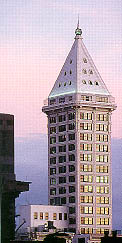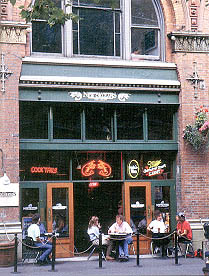| Physical Strategies | Functional Strategies |
|---|
Seattle:
Pioneer Square
Pioneer Square became Seattle’s first Historic District in May 1970. After the Square's long and tumultuous history, this achievement hardly seemed likely.

HISTORY
The spot known as Pioneer Square was chosen by the first permanent white settlers in 1852. This was the only flat area along the harbor; combined with the abundance of forests in the surrounding area, this was an ideal place for the lumber industry to take hold. The first business of the area was a sawmill. Other businesses quickly grew up around this creating a strong economy. One June 6, 1889, a fire destroyed 25 buildings in the city’s core. However, because of the strong economy rebuilding started immediately. Many of the buildings of Pioneer Square were rebuilt using the architecture style Richardsonian Romanesque. Because of the tragedy, the city council passed an ordinance that required buildings to be constructed in brick and stone. At this time, because most of the city was originally built on marshland, the area was filled, and street levels raised.

REVITALIZATION
Pioneer Square was economically sound through the time of the Alaska Gold Rush, but fell into decline after the turn of the century when the business district moved northward. Pioneer Square became a haven for taverns, junk shops, flophouses and the homeless. This decline continued until the 1970s. Because there was little threat for re-development, all of the Richardsonian Romanesque buildings built at the turn of the century remained standing.
Much like Pike Place Market, also in Seattle, in the 1960s the city had made plans to raze part of Pioneer Square for the construction of parking lots and a ring road around the downtown. Also much like Pike Place Market, it took the actions of concerned citizens to save this neighborhood. Ralph Anderson, a local architect, essentially started the movement to save Pioneer Square. He mortgaged his house in order to buy a $30,000 building, in which he located his office. Other prominent Seattleites such as architect Victor Steinbrueck, investor Alan Black, and Mayor Wes Uhlman rallied for the cause of saving the community.
With strong citizen support, Pioneer was established as Seattle’s first Historic District in 1970. A District Review Board was created to preserve the areas historic and architectural heritage. The board also established guidelines to certify the careful restoration of buildings.

PIONEER SQUARE TODAY
Today the Square is a place full of contrasts. It contains Seattle’s finest book stores, galleries, clubs, nightlife, and restaurants; all the while containing half a dozen homeless shelters which house 500 homeless men and women, and many panhandlers. The population of Pioneer Square is 1485; the number of businesses is approximately 500.
The people of Pioneer Square feel good about their community; although the majority desire more affordable housing, parking, and storefront police stations. Public safety is of top concern to most of the residents and business owners. In 1996 there were 1249 thefts, robberies, assaults, and burglaries. While this number may seem quite high, the size of the community is one-quarter square mile, and the number of weekly tourists reach into the thousands. Many residents feel that it is the drunken sports fans that wander over from the Kingdome that are creating the crime problem.
Merchants are concerned that over time, the Kingdome will bring in many souvenir shops and chain stores to the highly mixed use, quaint atmosphere of their community.
Today Pioneer Square is a thriving community within Seattle. The eclectic mix of people and stores create a wonderful atmosphere conducive to success. It took the actions of concerned entrepreneurs and citizens to save the future of Pioneer Square, and it remains a testament to the people of Seattle that their voices will be heard.
Page Author: Chris Thom
| Physical Strategies | Functional Strategies |
|---|
.
